Everything You Ever Wanted to Know About Land Sailing
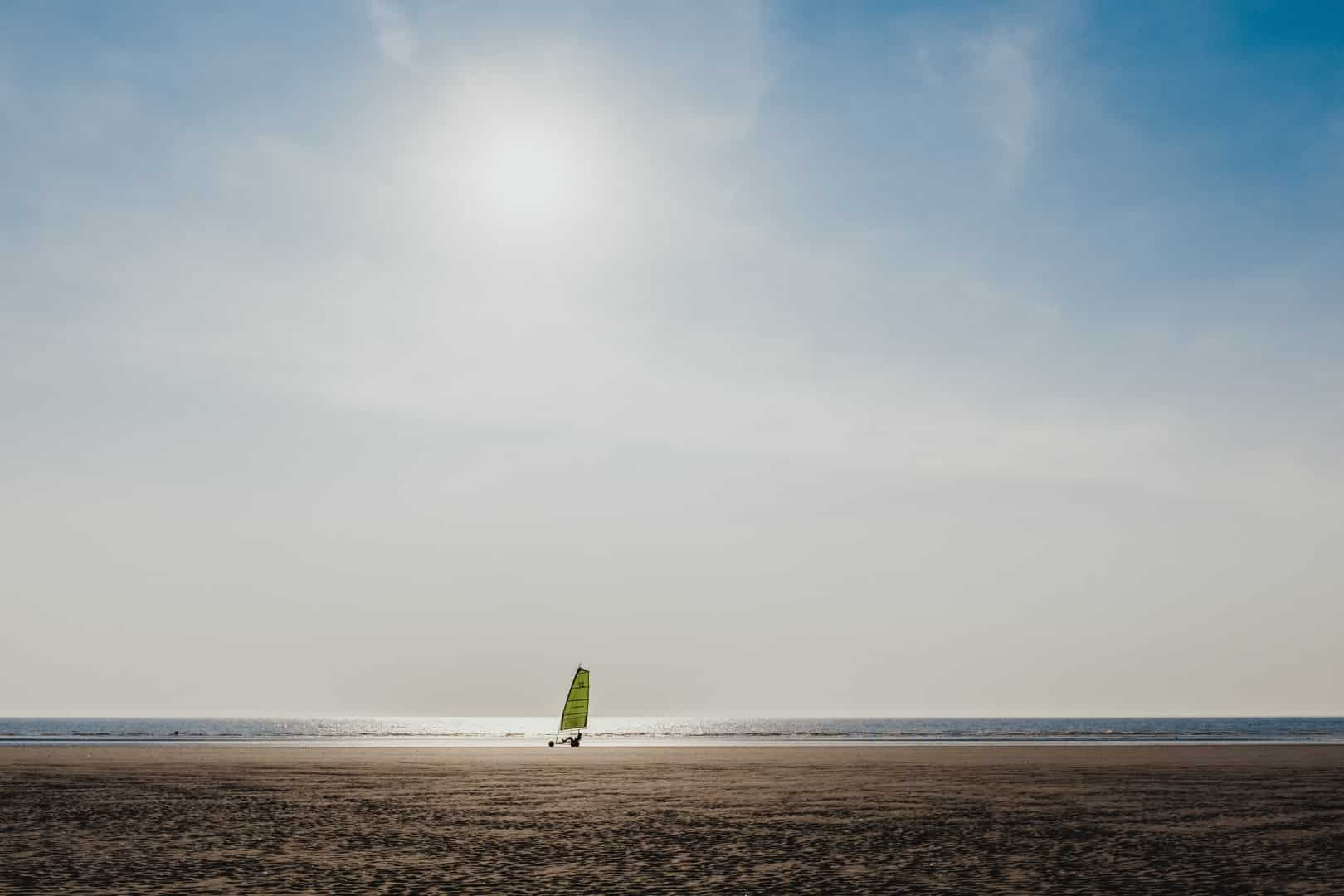
A beloved sport across the globe… by those who’ve tried it. This lesser-known sport gives an adrenaline rush like no other, with high speeds, beautiful scenery and the possibility to be practiced year-round. We’ve compiled everything you need to know before you try it…
What is Land Sailing?
A great sport for beach lovers; as it’s practiced predominantly on firm sand beaches, or those who like to go fast; as you’re able to go 3 – 4 times the wind speed… land sailing is the best adrenaline-seeking sport you’ve (probably) never heard of!
Practiced around the world, as it only requires a long flat stretch of beach, desert or flat ground, this lesser-known thrill-seekers sport is a great activity to try with friends and family. If you don’t fancy getting wet, but like the sound of racing down an empty beach, then this is the sport for you!
A sport that goes by many names, it’s hard to find just the one common name, being known by a whole host of titles over the globe… including Blo Karting, Land Yachting, Sand Sailing, Char à Voile (in France), Carrovelismo (in Argentina)… to some in the USA it’s known as Dirt Boating – with another names such as Wind Karting, Sand Yachting, Kite Buggying and Beach Sailing popping up across the globe!
An incredible adrenaline rush, land sailing, (though requiring minimum wind speeds of 10mph), offers you the chance to reach up to 3 or 4 times the wind speed of the area you’re doing it in! It’s also a great year-round sport, with the best times of the year to practice it being between March – November in America and Europe due to the weather.
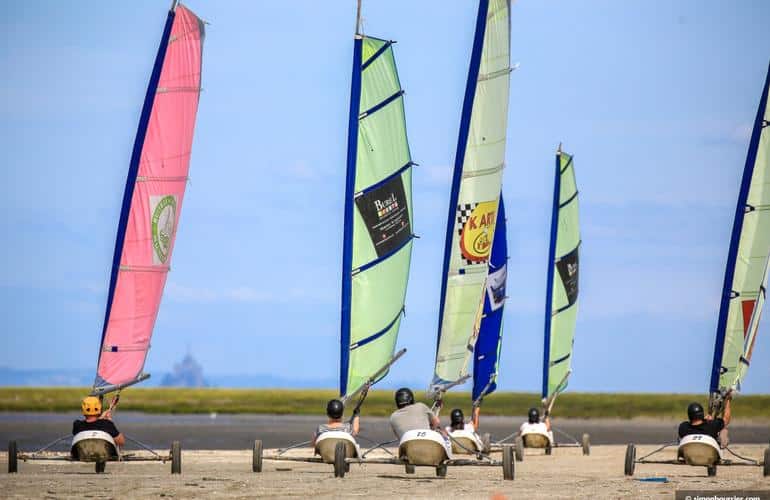
The history of Land Sailing
Throughout the modern and ancient histories of civilisations around the globe, wind-powered vehicles resembling land yachts have appeared sporadically, with the first known and recorded historical mention of a vehicle resembling a sand yacht dating all the way back to the times of Ancient Egypt. However, this machine, alike that also mentioned in the history of the Ancient Chinese civlisation of the Liang Dynasty, was created and used for non-recreational purposes, and instead for transporting materials and people efficiently.
Beginnings of the sport –
Cut to more recent history and 16th century Belgian engineer Simon Stevin, designed and built a ship, though notably bigger than a modern land yacht, again to transport a large number of people, across a number of North Sea beaches. In the same area, but three centuries later, a pair of Belgian brothers, the Dumont’s, in 1898, what is widely recognised to be the first modern land yacht used for recreational and sporting purposes – with the first official competition taking place in 1909 in Belgium. These vehicles then began to be mass produced around this time, under the title of the ‘aeroplane’ – though they didn’t take flight like the aeroplanes of today, by French vehicle manufacturer and char à voile enthusiast, Louis Bleriot.
With the two world wars in Europe, progression of this sport and of this vehicle halted, except for the notable work of Henri Demoury, who built several more land yachts for recreational purposes to ‘sail’ in the Le Touquet/Merlimont areas of northern France. The first French sand yachting clubs sprung up on the beaches of northern France in the 1950s.
Today –
Since then the sport has grown in popularity and spread across the globe from its home in the stretches of Northern Europe’s beaches. Popular due to its accessibility for beginners, and most ages (depending on the strength of the wind in some areas) and due to its fast-paced adrenaline thrilling nature and ability to be experienced on most terrains.
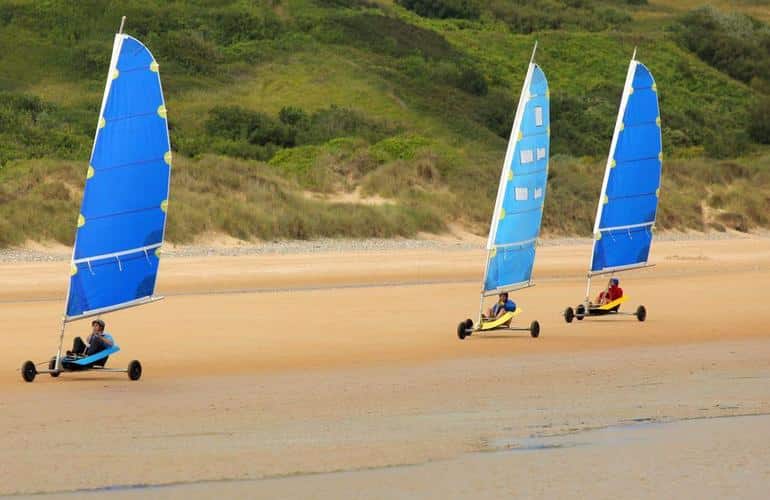
Equipment needed for Land Sailing
There are two main components when it comes to the equipment needed when practicing this sport – the land yacht (there are 4 main types) and the protective equipment (these land yachts can go fast and can tip up on two, or sometimes one wheel, so it’s best to be prepared!)
Firstly, land yachts are essentially three-wheeled karts or buggies with a large main sail, under which the driver sits either with their legs exposed to the elements or inside a main ‘body’ or ‘fuselage’ of the kart with their feet on pedals with which they steer. These vehicles almost resemble sailboats, except for their wheels and can sometimes hold two people.
To steer the land yacht, you push on the right pedal to turn left and on the left pedal to turn right, with some land yachts having the option to hand steer instead.
Types of Kart –
The four main types of land yacht are the ‘Standart,’ the standard model, the ‘Mini Yacht’ a smaller, more beginner-friendly version of this vehicle, the ‘Class 3,’ a larger and the fastest of the land yacht types and the ‘Class 5’ a version of the land yacht used more commonly in competitions.
Protective Gear –
In terms of protective gear, keep safe by wearing gloves, goggles, knee and elbow pads and a helmet, and to keep warm in wintry weather – as this sport can be practiced year-round, wear waterproof clothing and suitable footwear.
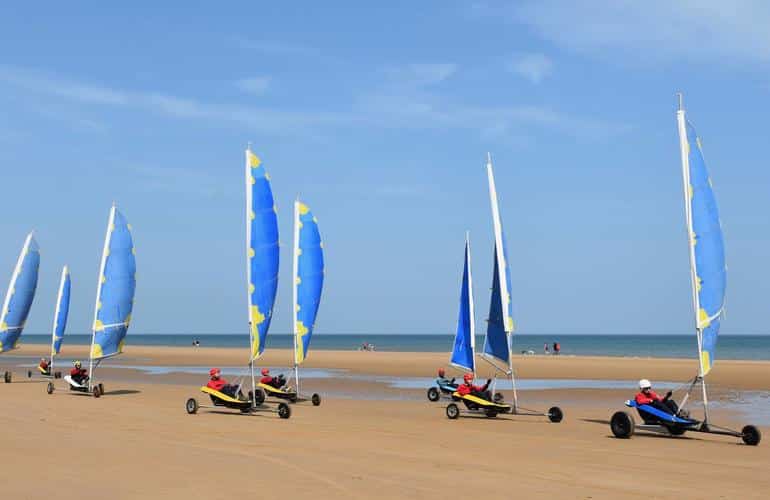
Who can do Land Sailing?
Land sailing is an exciting sport, that’s easy to learn, great fun to try as a beginner and a blast for both adults and children (over a certain age) to do.
This sensational sport gives a real adrenaline rush, takes you on a ride of speeds ranging from 5km/h to 80km/h, and even higher for those competing at it. Due to this variable speed and depending on the course, the weather and tide (if practiced on a beach) then it can be sometimes not so accessible for younger children.
However, there are many locations known for slower wind speeds and on surfaces such as short grass, where it is safer for children to try the sport out for themselves. There is also the option of using a two person kart in some locations, so that adults and children can practice the sport together.
Land sailing is the perfect sport to do in groups, as a family or with friends, and a great way to see new places.
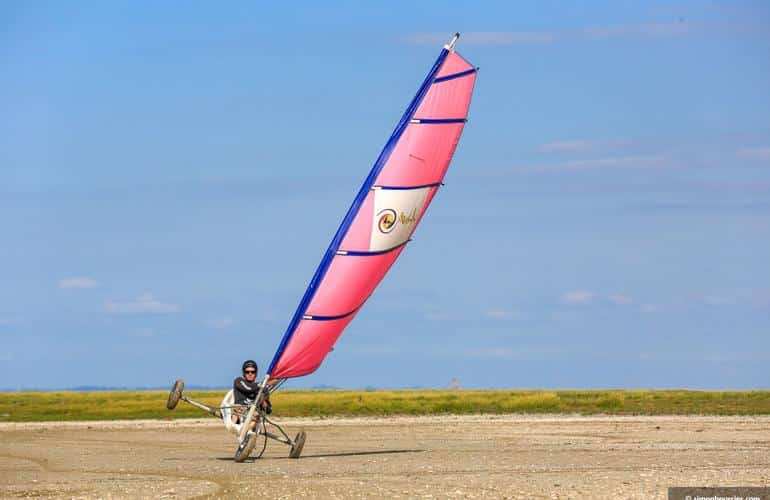
Variations of Land Sailing
Known by a multitude of names across the globe, this sport has variations such as ‘ice yachting’ – which, as the name suggests, is done on ice, in locations such as on frozen lakes in Scandinavia and Canada. The main difference between land sailing and ice yachting is that the latter is done with elongated ‘blades’ (resembling those that are used on ice skates), instead of the three wheels that land yachts have.
Land windsurfing, a variation of a different sport, windsurfing, resembles land sailing in that it’s practiced on similar terrains, and again harnesses the power of the wind for movement. However, land windsurfing has a four-wheeled board on which the person stands, rather than a light metal fuselage in which someone sits, as in land sailing.
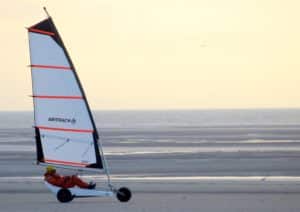
Iconic Land Sailing locations
A worldwide sport, requiring only a flat stretch of land, whether it be beach, desert or an unused airstrip, and at least 10km wind speeds, this sport is practiced in countries including, but not limited to: Belgium, Canary Islands, UK, France, the Netherlands, Spain, Cyprus, Austria, Lithuania and Switzerland, USA, Australia, New Zealand, Brazil, Argentina, Zanzibar, and South Africa.
With thousands of locations globally to practice this sport, land sailing lovers are quick to admit that the most popular and maybe even beloved spots are the beaches of Normandy and Brittany in France, as well as a number of locations in California and Nevada. The sport is popular all along the south coast of England, as well as along stretches of the coast of the Netherlands and Belgium, which have great beaches to try this activity. Whereas in locations such as the USA, Argentina and Australia, land sailing is done on dry, arid areas such as deserts.
Oceania –
Notable locations include New Zealand’s North Island’s ‘Ninety Mile Beach’ (which is actually 88 miles long) a great place to practice the sport because of the sheer amount of seemingly never-ending beach to cruise down.
North America –
Ivanpah Dry Lake, in the Mojave Desert, California, is another iconic location for practicing land sailing due to the historical and cultural relevance, as it is where Richard Jenkins, a British Engineer broke the land speed record for a wind-powered vehicle (which he did in his land yacht.)
Europe –
The beaches of Normandy, such as Omaha Beach, a WWII D-Day Landing beach – another great destination due to the history of this area, as well as the beautiful scenery of northern France.
South America –
The El Leoncito National Park, specifically on the Pampa del Leoncito in north-west Argentina, is a great place to try the sport. This large dry lake bed is a popular spot for practicing ‘Carrovelismo,’ a beautiful location with stunning views of the surrounding mountain ranges, and great wind speeds to really get the maximum adrenaline rush.
Top Photo Credit: Bernard Hermant